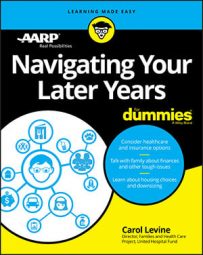The Family Caregiver Alliance has a helpful and exhaustive checklist for downsizing a home in preparation for a move. Also look at AARP’s Downsizing the Family Home, and the accompanying workbook, to walk you through the process. But in the following sections I cover some key points.
Note: If you or your parent has accumulated lots of stuff over the years and is determined to keep it, you may have to deal with a hoarding problem.Most of the moving process consists of the same steps you would go through if you were moving to a new home, new town, or even overseas. Moving from a familiar place to the unknown, and giving up all the familiar surroundings, can be hard, even if the move is welcomed and appreciated. Be patient and sensitive to feelings of sadness and the memories associated with the home and its contents. Allow time to do things right.
Getting started
Start the process of decluttering well ahead of the move. Doing it in small steps — a few hours a day — makes it less upsetting and reduces the chances that important items will be discarded by mistake. Do the following to make the process go smoothly:- Shred canceled checks and other unneeded papers that have personal information. Check with an accountant about what records need to be retained.
- Toss outdated food.
- Take unused or expired medications to a pharmacy for instructions on safe disposal. Some pharmacies have postage-paid bags you can use to mail the drugs for proper disposal.
- Donate clothes or household items that won’t be needed in the new home.
Collect all important papers and keep them in one place. These may be deeds, wills, birth certificates, passports, discharge papers from the military, or other legal documents. These are hard to replace and may be necessary to obtain benefits or for other reasons.
- If children, siblings, or others have used the home as a storage unit for their high school or college textbooks, memorabilia, and other items with meaning only to them, ask them to reclaim and remove them. They may decide that these things are not so valuable after all and add them to the discard list, or they may be thrilled to have them back again.
Planning ahead
The more you do ahead of time, the easier the transition will be down the road. Be sure to- Start a notebook or computer file folder for the move. Include to-do lists, phone numbers, appointment times — anything that you may forget but will need at some point.
- Get estimates from moving companies. Better rates are available for nonpeak times (the middle of the month, for example).
- Make a floor plan of the new home, with accurate measurements and placement of doors and windows, so that you know exactly how much space there will be.
- Measure any big pieces of furniture (bed, chest of drawers, tables) and decide where they should be placed by the movers.
- Make plans for pets to be moved and accommodated in the new home.
- Refill prescriptions in advance.
- Obtain or order any medical equipment that will be needed so that it is delivered and in place when the move happens.
Sorting and packing
Use these tips to help make the packing stage of the move easier and quicker:- Go through one room at a time, starting with the easiest. Sort the items into piles: definitely save, possibly save, donate, and discard. You and your relative may have disagreements about what goes where. Try to compromise, but make sure that all truly unneeded and unusable items are discarded.
- Make packing an event to bring family and friends together. Having a group together takes away some of the anxiety and creates a positive atmosphere.
- Label everything with its destination.
- Make sure you keep all the items needed during the move in one place: keys, medications, clothing, legal documents, checkbook, cellphone, first-aid kit, cash, and your moving notebook (which I recommend in the preceding section).
Settling in
New connections will have to be made: membership in a new congregation, and a new doctor, dentist, dry cleaner, and barber or hair stylist are all important to feeling at home. Introduce your parent or child to neighbors and friends. Tour the community together to check out shops, libraries, and other services.After all the boxes have been unpacked and the furniture rearranged, take some time to get accustomed to the new arrangement. What didn’t work out exactly as planned? What adjustments need to be made? Don’t try to do everything at once.

